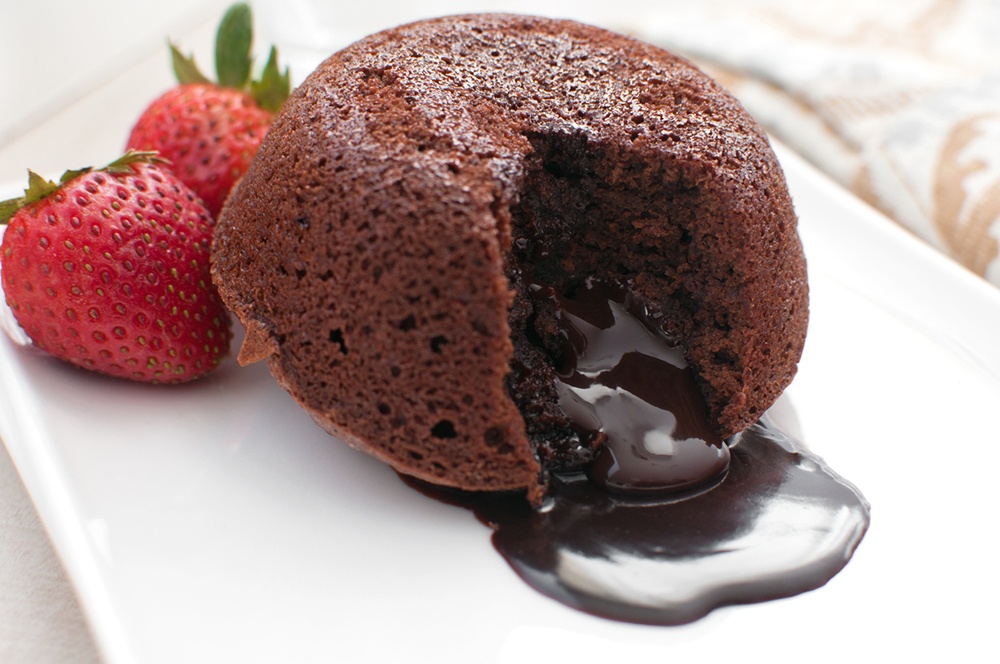Health writer and Chef, Kristen Boye, explains how to modify your favorite recipes to be healthier -- and still delicious -- this Valentine's Day (and throughout the year!).
Valentine’s Day is just around the corner…and it’s come far too soon for those of us who vowed to lose weight and eat less junk food this year.
But…what if you could have your chocolate cake and eat it too?
 The good news is there are simple ways to indulge your sweet tooth without derailing your health in the process.
The good news is there are simple ways to indulge your sweet tooth without derailing your health in the process.
I know because, in addition to being a health and wellness writer, I’m also a certified Natural Foods chef who happens to LOVE desserts.
In today’s post I will share my 5 best tips and recipes on how to bake a little healthier (so you can feel a little sexier) this Valentine’ Day.
Tip #1: Say buh-bye to wheat flour
Our nation has become slightly obsessed with gluten and its role in everything from weight gain to autoimmune disease.
But here’s the thing…gluten may not be entirely to blame.
Wheat, more specifically modern wheat, is not what it was even 50 years ago.
In the 2016 documentary: “What’s with Wheat?” scientists, farmers and nutrition experts lined up to explain how wheat has gone from a wholesome grain to an ultra-hybridized, pesticide-laden, over-processed food product, which is wreaking havoc on our digestive health.
If this sounds too radical to be true, just try cutting wheat out of your diet for a week or two and watch your waistline, digestion and energy improve.
The goods news is, there are healthier wheat options out there.
Two of my personal favorites for baking are:
- Whole Grain or All-Purpose Spelt flour: An ancient wheat flour available in most natural foods stores or online.
- Whole Grain or All-Purpose Einkorn flour: The most ancient, purest form of wheat, available in some natural foods stores or online. If you have serious wheat sensitivities, Einkorn is your best option.
Both are types of traditional wheat, but they have been far less hybridized, processed and engineered that typical wheat flour.
They also contain shorter chains of gluten which are easier to digest, and they’re more nutritious than modern wheat flours.
Even better, they couldn’t be easier to use.
Just pick your flour (whole grain or all-purpose) and substitute 1 to 1 for wheat flour in your baked goods.
Healthier (sexier) recipe: Molten Lava Cakes for 2 (with spelt flour)

Tip #2: Replace white sugar with nutrient-rich alternatives
When NPR ran last year’s expose entitled: “50 Years Ago, Sugar Industry Paid Scientists to Point the Blame at Fat”, any doubts (or denials) about the detriments of consuming too much sugar were put to rest.
Yes, sadly it’s true.
White sugar (not saturated fats) has “officially” been causing heart disease for the last several hundred years. If we ever wondered why we couldn’t defeat heart disease with a low-fat diet, perhaps this is why.
White sugar is also insanely addictive and has been linked to a host of other diseases from cancer to ADD/ADHD.
But what exactly makes it so bad for us?
Part of the reason sugar is so detrimental is that it’s been completely stripped of its own nutrients, like B-vitamins and minerals. So as it enters your body, it robs you of key vitamins, minerals and enzymes to facilitate its own metabolism.
Fortunately, there are some great unprocessed alternatives that allow you to have your cake and eat it too.
*Please note, because of its effects on blood sugar even natural sugar alternatives should be consumed in moderation.
Here are some of my favorites for non-diabetics:
- Coconut Sugar: This affordable and delicious sweetener comes from the natural sap of the coconut tree. That sap is collected, dried and powdered for your baking pleasure leaving all its nutrients in-tact.
Conversion: 1:1 for white sugar in baking or use it in your coffee for a delicious caramel flavor.
Works best for: Everything except white-colored desserts (like meringues).
- Maple Syrup: Rich in minerals like iron, potassium and magnesium, pure maple syrup makes an excellent natural sweetener in baked goods, custards, whipped cream and cookies.
For those who don’t know, maple syrup is made from the sap of maple trees. That sap is then boiled down into a syrup and bottled.
Grade A is recommended for baking because of its lighter color and flavor.
Conversion: Because it’s a liquid, maple syrup won’t work in ALL recipes but you can often substitute it for sugar by reducing other liquids in the recipe by 3 tablespoons.
- Maple sugar is another option but it’s expensive compared to coconut sugar.
Works best for: Custards, whipped cream, pies, crisps and some cookies/baked goods.
- Honey: Let me be clear. Though it is natural, nutritious and affordable…honey is not the answer for ALL desserts.
It’s sweeter than sugar and has a distinct flavor that may not play well with chocolate desserts or pastries.
Works best for: Fruit-based desserts, cakes, sticky buns, custards and whipped cream.
Conversion: To use, subtract ¼ cup of other liquids in recipe and lower your oven temperature by about 25 degrees.
- Real Sucanat: Sucant is sugar that hasn't had its nutrient-rich molasses removed. Molasses is rich in minerals like iron, selenium, B6 and magnesium. You have to be careful though, as not all sucanat (like evaporated cane juice and turbinado sugar) is created equal.
The best brand out there is Rapunzel Rapadura, which you can find at natural foods stores or online.
Works best for: Everything except white-colored desserts (like meringues).
Conversion: 1:1 for white sugar.
Diabetic? You have better options than artificial sweeteners
If you’re diabetic, or just want to avoid sugars altogether, try these non-synthetic alternatives to controversial artificial sweeteners:
- Stevia: A totally natural sweetener from the Stevia plant—used for centuries as an herbal blood-sugar balancer.
Though stevia is significantly sweeter than sugar, you can bake with it if you use good recipes. I love Chocolate Covered Katie for this, and here’s a good stevia conversion chart from sugarfreemama.com.
Look for pure stevia products, like SweetLeaf® (Truvia® is not pure stevia), at your local grocery store.
- Swerve®: Available at grocery stores everywhere, Swerve is an erythritol-based sweetener (AKA sugar alcohol from plants). It’s safer than artificial sweeteners, non-GMO and can be used 1:1 in place of sugar. The only downside is, because it’s a sugar alcohol, it can cause minor gastrointestinal issues like gas and bloating, which decreases the more you use it. Though this wouldn’t be my #1 choice, it’s easy to find, affordable and a heck of a lot better than artificial sweeteners…especially for diabetics.
Healthier (sexier) recipe: Chocolate Covered Katie’s: Chocolate Chip Cookie Pie (sweetened with stevia and dates)
Tip #3: Use real vanilla
Repeat after me: vanilla flavor is NOT vanilla.
Vanillin AKA “vanilla flavor” is an evil food-like vanilla imposter that comes from (wait for it)…wood pulp. It was created back in the 1870s as a cheap substitute before vanilla was so readily available.
Real vanilla costs a little more, but its flavor and real-food-ness is well-worth it.
Healthier (sexier) recipe: Art and the Kitchen’s Maple Syrup Crème Brulee
Tip #4: Try a healthier chocolate
In case you haven’t heard…chocolate has health benefits.
From its rich antioxidant profile to its stress-lowering (and aphrodisiac) benefits, science has proved a little chocolate may be good for what ails ya.
However, quality is EVERYTHING…here’s what to look for.
- Choose Fair-Trade Chocolate—to support farmers and help put a stop to child labor (read more here)
- The darker the better—dark chocolate contains all those health-giving antioxidants and contains less sugar
- Try stevia-sweetened chocolate—Lily’s chocolate bars and chips are sweetened with diabetic-friendly all-natural stevia, making them one of the healthiest chocolates out there
Healthier (sexier) recipe: Easy Chocolate Dipped Strawberries:
- Melt Lily’s stevia-sweetened chocolate OR organic dark chocolate according to package directions
- Dip organic strawberries into the chocolate (strawberries are one of those fruits you really want to buy organic)
- Let the chocolate harden in the fridge
- Indulge with the one you love

Tip #5: Choose your fats and oils wisely
We should all know by now that trans fats, like margarine and shortening, are the devil.
What’s more, new research is proving that cheap, highly-refined seed oils like canola, cottonseed and soybean oil are doing us more harm than good.
So what are the healthiest fats to cook and bake with?
- Coconut oil: the new “darling” of natural foods. Coconut oil contains a wealth of healthy, metabolism-boosting medium-chain fatty acids that your body can use for energy…instead of storing as fat.
For baking, use 1:1 in place of butter or margarine.
For flaky pastry: measure then freeze your coconut oil in a ramekin. Once solid, use a box grater to grate it into flour.
If you don’t like the taste of virgin coconut oil, use refined coconut oil for its neutral flavor.
- Avocado oil: neutral-tasting, full of healthy fatty acids and good-for-you, avocado oil can be used 1:1 in place of traditional seed oils.
- REAL butter: the jury’s in folks. According to studies as reported in Time Magazine it’s okay to eat butter.
Should you eat pats and pats of it? No. Moderation is the key. However, new research suggests it may be better for you than refined seed oils.
To really get the best bang for your buck, opt for organic and/or pasture-raised butter. It tastes 10X better and is at least 10X better for you.
Healthier (sexier) recipe: Elana’s Pantry: Heart-Shaped Paleo Sugar Cookies (gluten-free)
Additional Ingredient Sourcing Tips:
If you live a good distance from a natural foods store, you can have your healthier baking ingredients delivered (at a discount) from Vitacost, Amazon or einkorn.com.
Price clubs like Costco and Sam’s are also a great place to stock up on organic maple syrup, coconut oil, butter, avocado oil, some alternative flours, coconut sugar, real vanilla, vanilla beans and honey.
Wishing you a happy, healthy, sexy and SWEET Valentine’s Day (-:

























